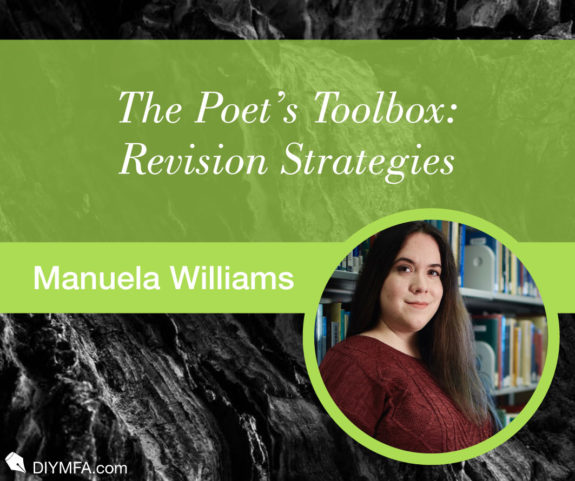Welcome back, poets! For me, revision has always been the hardest part of writing poetry. Should I cut lines out or add them in? Is the final line strong enough, or would the poem be served better by ending earlier? Is my title doing enough work? And how in the world do I know when a poem is “done?” Unfortunately, there aren’t easy answers to these questions, as every writer has their own set of strengths, weaknesses, and goals for their work. For instance, I absolutely adore cutting things out of poems. However, I am often stumped when trying to expand. As such, the revision strategies I use for my own poetry might look a little different from someone else’s.
In the past, I’ve shared resources on the craft of poetry. Today, I’m excited to talk to you about some of the revision strategies I’ve used in the past. I tried to include a variety of strategies, but this isn’t an exhaustive list, and you should feel free to experiment.
Before diving in, though, take a moment to do an assessment of your work (either alone or with a writing group). Are there areas in which you’re consistently getting feedback? Are there areas you want to improve upon? Make note of these and develop or find revision strategies that address your particular concerns.
Make a Self-Erasure
This revision strategy involves cutting out most, if not all, of the narrative connective tissue, or explanatory language in the poem. When I use this strategy, more often than not, my poem shrinks considerably, and all that I’m left with are disjointed images, or an “erasure” of my poem. This strategy helps me better identify the moments in the poem that are stronger, and the language that feels most emotionally charged. Additionally, it helps me see where the language is weaker so I can cut or revise those moments in the poem.
Expand by Exploring a Theme
During my last year of grad school, I suddenly developed a love (okay, more like an obsession) for the Gothic genre, particularly Gothic romance. I was interested in exploring this genre in a poem, but wasn’t exactly sure where to start.
As I began to draft the poem, I researched some of the most common tropes found in Gothic literature, specifically Gothic romance. I wanted to incorporate this research into my poem, but was worried that I’d simply be rewriting or restating a Wikipedia article instead of doing something new and exciting with the knowledge.
I turned to poet Louise Glück to help me, particularly her use of the lyric “I” and the seemingly personal/autobiographical reflections interwoven throughout her collection, Averno.
For example, in “Persephone the Wanderer,” a more scholarly diction is used on pg. 75: “When a god grieves it means / destroying others (as in war).” Later, on pg. 76, this tone appears to be reversed, and the poem becomes more personal and reflective when the “I” reappears at the beginning of the final three stanzas: “I think I can remember / being dead. Many times, in winter, / I approached Zeus. Tell me, I would ask him, / how can I endure the earth?”
I really admire this technique, and still use it today, weaving the scholarly material in between the more autobiographical elements. I think this adds more texture to my poems as a whole, and uses my research in a way that isn’t simply restating or rewording theoretical analyses or tropes, but reimagining them within the context of my own experiences.
Start Earlier, End Sooner
The next revision strategy that has worked well for me is starting a poem later and ending it earlier. I often find myself taking a while to get to the “meat” or emotional center of the poem. When that happens, I’ve found that the beginning stanzas of the poem are weaker, or less exciting, than the second half of the poem.
I’ve found it very helpful to identify the places where the language is the most intense. When I do that, I cut out everything that comes before that moment, or I rearrange the poem so that I begin with the most compelling images or lines.
Another one of my poetic tendencies is to explain the “moral” or “takeaway” of a poem in the last stanza. In order to solve this issue, I will usually look to my last stanza, since that is where I do a lot of the explaining work, and completely cut it. Often this is enough to open up the poem a little more, and prevent it from snapping shut too soon.
Switch Things Up
Sometimes, a radical revision is the best kind of revision. Is your poem written in a more traditional form? Try writing it in prose instead. Did you write a prose poem? You might find it useful to use the “self-erasure” strategy above.
Back to you, poets!
Have you tried any of the above revision strategies? Let us know in the comments!

Manuela Williams lives and writes in Nevada. She is the author of two poetry chapbooks and one paranormal fiction novella. When she’s not writing, Manuela loves reading romance novels, drinking *all* the coffee, and playing video games. You can find her on Twitter right here.







